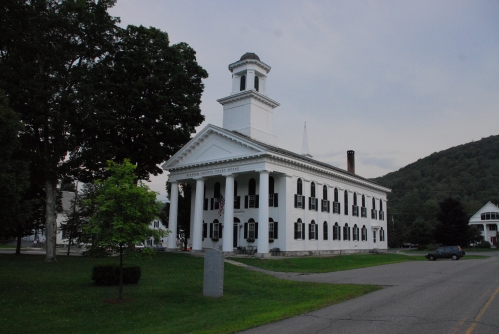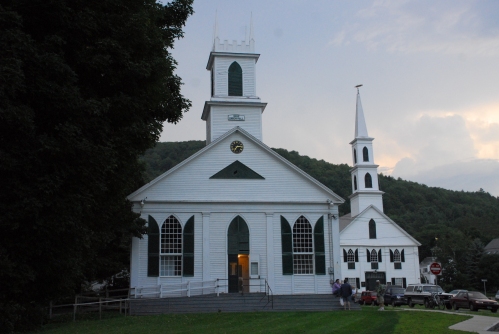Clackamas County Oregon
September 4, 2008 ·
A classic example of the mid thirties “Brick Box” courthouse is the Clackamas County Courthouse in Oregon City Oregon. At the end of the Oregon Trail, it has been the site of many historic trials in Oregon’s history.
By the way, does anyone know what the significance of the guys above the door lentil’s are? If so, drop me an e-mail, I have seen them on a number of courthouse.
Windham County Newfane, Vermont
August 30, 2008 ·
The village of Newfane was founded in 1774 on Newfane Hill. Within a few years there were twenty houses, a courthouse, an academy, three stores, two hotels a meetinghouse, various repair shops, a jail, and a whipping post.
After a certain amount of maneuvering, the Town of Newfane became the shire town in 1787 (i.e. the county seat), and in 1825 the hardy citizens moved their village down off the hill to the flats around Smith Brook where there were only a few houses. They took some of the buildings apart, brought them down on ox sleds and put them up again. (Among these were part of the present Newfane Inn and the two houses south of the church.) Mostly, they had to build anew. In that first year a small general store quickly appeared where the Newfane Store now stands, while the county erected a brand new court house and a jail at a cost $10,000. A meetinghouse went up in 1832 (now the Union Hall) and a few years later the Congregational Church. During the next decade houses went up one after another on Pleasant Street (now West Street) and Main Street (Route 30); so the village you see now was mostly in place by 1850.
Windham County Court House: 1825, 1853, and 1907
Originally the courthouse was a Federal-style, box-like structure, it’s roof pierced by four chimneys. In 1853 the porch and four beautiful Doric columns that were added produced its Greek Revival aspect. In 1907 the building was further enlarged at the opposite end. Court sessions are held here, and have been for the last one hundred and sixty years.
This meetinghouse was built by a group of “liberal and charitable” Christians as a Center for religious freedom and worship by all sects that contributed to the cost. The contract price was $1600, but there were a few extras; $14.50 for alterations and $12.00 for a lightning rod. After twenty years it was abandoned, then converted to public hall in 1872. It is now used for meetings, weddings, concerts, movies, auctions, etc.
First Congregational Church (Church Street): 1839
The Congregational group soon became dissatisfied with their meeting house (now the Union Hall) as their place of worship: so they raised $4,000 and erected a church to accommodate three hundred people. Like so many New England churches it emulates in wood those built of stone by the English architect, Sir Christopher Wren. The decorative features are Greek Revival, but with a Gothic Revival overlay that was added later. (Note the pointed-arch windows and shutters)
Fossil Oregon
August 29, 2008 ·
 In my first post yesterday, I talked briefly about the Wheeler County Courthouse in Fossil, Oregon. Built in 1901, it probably has fewer folks using it now that it did when it was built. The site of a murder trial for a miner who was not very successful and started knocking off other miners in the early 40’s, it just looks like a wild west courthouse! As you can see, it sits on the edge of town, but in actuality, the other edge is pretty much across the street!
In my first post yesterday, I talked briefly about the Wheeler County Courthouse in Fossil, Oregon. Built in 1901, it probably has fewer folks using it now that it did when it was built. The site of a murder trial for a miner who was not very successful and started knocking off other miners in the early 40’s, it just looks like a wild west courthouse! As you can see, it sits on the edge of town, but in actuality, the other edge is pretty much across the street!

I did not get this guy’s name, but I thought that he was perfect for the town of Fossil!
My Original Post
August 29, 2008 ·
Tuesday, August 19, 2008

A number of years ago I started thinking about documenting the interesting courthouses I have argued in over the years. I took a picture of the Wheeler County Courthouse in Fossil, Oregon, and filed it away. I am now photographing courthouses wherever I go, and intend to post them here, along with a little history on each.








No comments:
Post a Comment